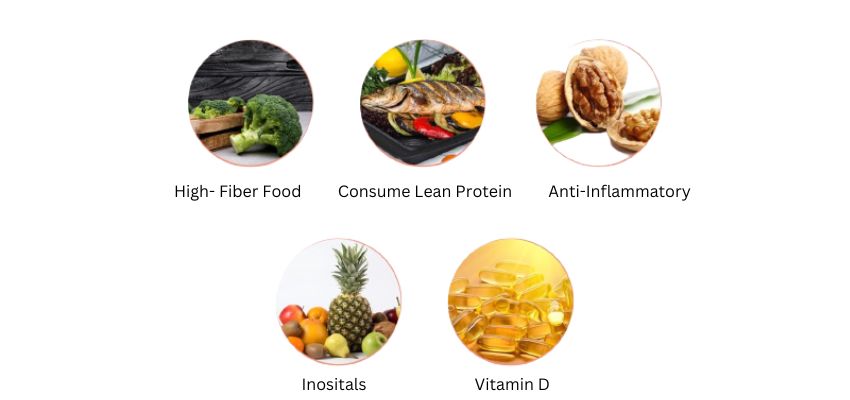PCOD (Polycystic Ovary Disease) is a hormonal disorder that affects a woman’s reproductive system. A healthy PCOD Diet Chart can help regulate hormones, reduce inflammation, and improve fertility.
Symptoms of PCOD include irregular menstrual cycles, excessive facial and body hair, acne, and weight gain. A healthy diet can significantly reduce the severity of PCOD symptoms and improve overall health. Eating a balanced diet rich in fiber, lean proteins, and unsaturated fats can help regulate hormones and decrease inflammation.
Eating foods high in vitamins and minerals, such as leafy greens and whole grains, can also help increase fertility. Limiting processed and refined foods, as well as reducing sugar and saturated fats can significantly reduce the severity of symptoms and improve overall health.
It’s possible that type 2 diabetes, morbid obesity, obstructive sleep apnea, heart problems, psychological issues, and endometrial cancer could be the long-term consequences of PCOD, if not treated on time. An early diagnosis can help in preventing upcoming symptoms.

How PCOD Diet Chart Helps You
You can begin to control the symptoms of PCOD and keep up a healthy lifestyle by following a PCOD Diet Chart program. Nutritional guidelines generally suggest eating green and leafy vegetables, in addition to foods that help the body receive sufficient nutrients.
Moreover, you should also exercise regularly and reduce your stress levels to help manage PCOD symptoms.
Diet affects Polycystic Ovary Disease in two ways: insulin production and resistance, and weight management. It should be noted that insulin plays an active role in PCOD. Therefore, one of the most effective ways to treat the condition is to follow a PCOD Diet that controls insulin levels.
Follow a PCOD Diet Chart that meets your nutritional needs, helps you lose weight, and stimulates healthy insulin levels for the most effective results. For type 2 diabetes, it is recommended to limit fat intake to 25-35% of total daily calories, with no more than 7% coming from saturated fat.

The food you should include in your PCOD Diet Plan:
A PCOD diet Plan should focus on nutrient-dense, high-fiber foods such as fruits, vegetables, and whole grains while avoiding processed and sugary foods.
A PCOD diet should focus on nutrient-dense, high-fiber foods such as fruits, vegetables, and whole grains while avoiding processed and sugary foods.
- A low-GI diet
Foods that are digested more slowly by the body do not raise insulin levels as rapidly as food products with a higher glycemic index GI, such as some carbohydrates.
Whole grains, legumes, nuts, seeds, fruits, non-starchy vegetables, and other low-carbohydrate, unprocessed foods make up a low GI diet.
Additionally, such a diet provides many health benefits, including improved blood sugar control, improved cholesterol levels, and reduced risk of developing some chronic diseases.
- Fruits and green leafy vegetables
PCOD diet plans should include fruits every day. You can include fruits like apples, strawberries, blueberries, blackberries, red grapes, cherries, and cherries in your diet.
These fruits have a minimal glycemic index (GI), which will be healthy for insulin sensitivity. Fruits with a low glycemic index are digested slowly, providing steady energy and helping to maintain a healthy weight. This helps to control blood sugar levels and minimize the risk of insulin resistance.
Combining these fruits with green vegetables could be a better choice to make.
Green leafy vegetables contain essential vitamins and minerals like Vitamin A, Vitamin E, potassium, magnesium, and zinc. These vitamins and minerals can help reduce inflammation, regulate hormones, and improve blood circulation, which can help reduce the symptoms of PCOD.
Additionally, they are packed with antioxidants which can help improve skin health. Green leafy vegetables like kale, broccoli, and spinach are great assets to a PCOD Diet Chart.
- High-fiber food and nuts
PCOD Diet plan should include fiber-rich foods like beans, avocados, nuts, peas, and oranges because they help regulate PCOS symptoms. Many nuts, including almonds, walnuts, pistachios, and pine nuts, are high in healthy fats that can help with PCOD treatment.
For example, almonds are a good source of Vitamin E and magnesium, which can help reduce inflammation and balance blood sugar levels.
Foods you should avoid in your PCOD Diet Chart

- Sugary Beverages. Sugary drinks like sodas, sweetened or sparkling water, sports drinks, etc.
- Refined Carbs. Breakfast cereals, pastry, cake, pizza, or anything that contains white flour.
- Processed Foods. Fried chicken, flavored potato chips, frozen or blended coffee, etc.
Conclusion
To optimize the effectiveness of the treatment, it is important to make healthy lifestyle choices and stick to them consistently. Doing this will not only help in controlling and curing Polycystic Ovary Disease but also in achieving greater overall health and well-being. It’s better to maintain a healthy PCOD Diet Chart before being symptomatic of it.


